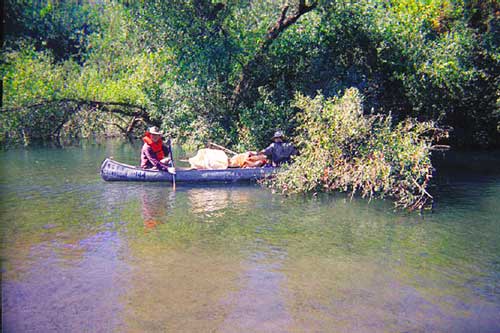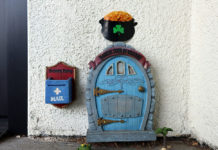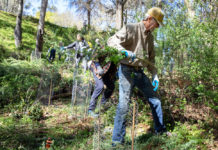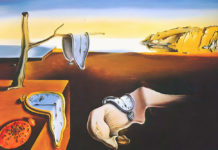Believe it or not, there are still people who treat the world
around them like their personal trash can.
Tossing a cigarette butt out the window along a stretch of
concrete and asphalt is one thing, but thousands of our fellow
Californians regularly mistake the state¹s beaches for the world¹s
largest ashtray.
Don¹t believe it?
During last year¹s annual coastal cleanup, volunteers collected
258,000 cigarette butts from the beaches of the Golden State.
Last year¹s Russian River Watershed Cleanup netted nearly 200
tires that were discarded by the less environmentally conscious of
those among us.
If this abuse of nature and the general slovenly behavior of
your friends and neighbors disgusts you, the next two weekends are
the perfect opportunity to do something positive about it.
The Coast & Creek Cleanup Day is this Saturday, Sept.16,
followed the next weekend by the Russian River Watershed Cleanup on
Saturday, Sept. 23.
Last year during the annual Sonoma County Coast & Creek
Cleanup Day, more than 1,000 volunteers collected 11,461 pounds of
trash, 7,000 pounds of recyclable material and three tons of scrap
metal from the county¹s coast and creeks.
This year the volunteer turnout is expected to be even greater,
according to Willow Taraja, a staff member at Coastwalk and the
coordinator of the Saturday, Sept. 16 event.
³Between the coast and the inland sites, I feel like we¹re going
to have 1,500 people,² said Taraja. ³We¹ve got a lot of groups
coming ‹ everything from 10 girl scouts to 50 Kiwanis Club members.
The Coast Guard is sending 200 cadets.²
Volunteers will scour 30 miles of beach and waterways at 30
different locations.
The Russian River Watershed Cleanup typically attracts about 400
volunteers, according to Debora Fudge, a Windsor Town Councilmember
and one of the coordinators of the event for the past 16 years.
Last year, volunteers hauled out 14,000 tons of trash.
³This is important because every single year we take out 14,000
pounds of trash and debris and 200 tires,² said Fudge. ³The reason
we keep going is if we skipped a year there would be 28,000 pounds
of trash and debris the next year and it would just keep
accumulating.²
Next weekend¹s beach and creek cleanup promises more than just
work gloves and plastic garbage bags, said Taraja. Following the 9
a.m. to noon cleanup at various sites, there will be a Volunteer
Appreciation Barbecue at Doran Beach jetty area, with grilled
organic chicken, compostable picnic supplies and contests and
prizes.
³We really want to get people pumped up about the debris art and
sand sculpting contest,² said Taraja.
The Most Unusual Debris Contest, which is held first, should be
worth the price of admission alone.
What¹s the most unusual debris she can remember? ³What you can
print in your paper is that we found a personal check from an Idaho
bank written to Taco Bell with a dollar amount ($23) written in,²
said Taraja. ³We have no idea where it came from.²
It gets racier. The county¹s litter bugs may be careless, but
perhaps some have other things on their minds.
³We find a lot of lingerie,² she said. ³Sonoma County finds a
lot of lingerie and accoutrements to go with the lingerie.
³On the more mundane side, we find a lot of boating debris.²
The most plentiful of the discarded items are the remnants of
the increasingly unpopular tobacco habit.
³The number one item is cigarette butts,² said Taraja.
This is more serious than you may think. ³People think the
filters are made of cotton, but they are made of plastic and they
break down so small that in the water they appear to be
phytoplaknton.
³They break down into a very neutral color and they float on the
surface just like phytoplankton.² One study shows that in the North
Pacific, plastic far outnumbers phytoplankton.
According to information from the Algalita Marine Research
Foundation, ³Most plastic floats near the sea surface where some is
mistaken for food by birds and fishes. Plastics are carried by
currents and can circulate continually in the open sea. Broken,
degraded plastic pieces outweigh surface zooplankton in the central
North Pacific by a factor of 6-1. That means six pounds of plastic
for every single pound of zooplankton.²
The coastal and creek cleanup ³is not just for the health of the
marine animals, it is for the health of all of us who recreate on
our beaches and waterways,² said Taraja. ³We need to make more of
an effort to pay attention to our inland and coastal
watersheds.
³We can stop the source of trash at our inland communities …
people don¹t realize that when they throw things in the storm drain
that it empties directly to the creeks and to the river and the
ocean. That is a very common disconnect that happens.²
Fudge said Russian River cleanup volunteers are a loyal bunch.
³Of the 400 volunteers we have about 200 returnees,² she said.
³They actually claim beaches, they adopt them as their own and they
won¹t give them up.²
At the end of the day, volunteers will receive a commemorative
canvas bag, a refreshing change from the many hats and t-shirts
loyal volunteers have collected, said Fudge.
³People are impressed with the quantity of what they pull out of
the river every year,² she said. ³And when they see the piles, they
are really proud.
³There is room for everyone. We¹ve never turned anyone
away.²
To volunteer for the Russian River Watershed Cleanup, go to
www.russianrivercleanup.org
To sign up to volunteer for the Sonoma County Coast and Creek
Cleanup, call the Coastwalk office at 829-6689, ext. 5 or arrive at
8:15 a.m. on Sept. 16 at the Salmon Creek Ranger Station to receive
a beach assignment.
43
F
Healdsburg
March 15, 2025









